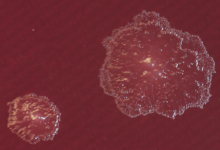Turicibacter
| Turicibacter | |
|---|---|

| |
| Turicibacter sp. H121 cells under microscope | |

| |
| Turicibacter sp. H121 colonies | |
| Scientific classification | |
| Domain: | |
| Phylum: | |
| Class: | |
| Order: | |
| Family: | |
| Genus: | Turicibacter Bosshard, Zbinden and Altwegg 2002
|
| Strains | |
|
Turicibacter sanguinis MOL361 | |
Turicibacter is a genus in the Firmicutes phylum of bacteria that has most commonly been found in the guts of animals.[1] The genus is named after the city in which it was first isolated, Zurich (Latin = Turicum), Switzerland.[2]
Phylogeny
The position of Turicibacter within the Firmicutes could not be resolved using 16S rRNA gene-based analyses. However, it was tentatively placed in the class Bacilli, then the class Erysipelotrichia.[3]
In a tree built using a concatenated protein alignment containing data from two draft Turicibacter genomes, the group was placed at the base of the class Bacilli.[4] Later analyses that also included amino acid sequences predicted by a complete Turicibacter genome came to the same conclusion.[1]
References
- ^ a b Auchtung TA, Holder ME, Gesell JR, Ajami NJ, Duarte RT, Itoh K, Caspi RR, Petrosino JF, Horai R, Zárate-Bladés CR (2016). "Complete Genome Sequence of Turicibacter sp. Strain H121, Isolated from the Feces of a Contaminated Germ-Free Mouse". Genome Announcements. 4 (2): e00114-16. doi:10.1128/genomeA.00114-16. PMC 4807225. PMID 27013036.
- ^ Bosshard PP, Zbinden R, Altwegg M (2002). "Turicibacter sanguinis gen. nov., sp. nov., a novel anaerobic, Gram-positive bacterium". International Journal of Systematic and Evolutionary Microbiology. 52: 1263–1266. doi:10.1099/00207713-52-4-1263. PMID 12148638.
- ^ Bosshard PP. "Genus VIII. Turicibacter Bosshard, Zbinden and Altwegg 2002, 1266VP". In De Vos P, Garrity GM, Jones D, Krieg NR, Ludwig W, Rainey FA, Schleifer K, Whitman WB (eds.). Bergey’s manual of systematic bacteriology, 2nd ed. The Firmicutes. Springer. pp. 1314–1315.
- ^ Segata N, Börnigen D, Morgan XC, Huttenhower C (2013). "PhyloPhlAn is a new method for improved phylogenetic and taxonomic placement of microbes". Nature Communications. 4: 2304. doi:10.1038/ncomms3304. PMC 3760377. PMID 23942190.
